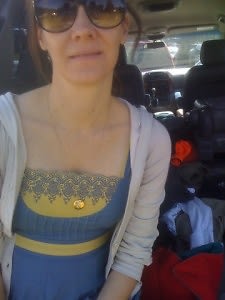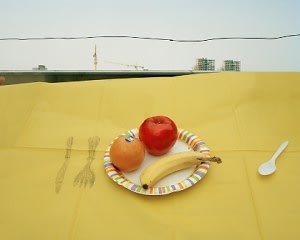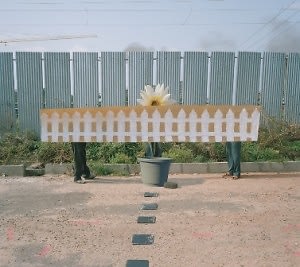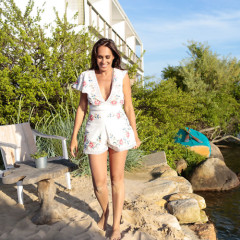Melting chicken masks and actors falling off houses were just a few of the problem New York-based photographer Stuart Hawkins faced while creating her newest body of work Broken Welcome in Calcutta, India.
 Check out this exclusive interview with the nomad artist-turned-Manhattan wife and mom (yup, Stuart's a woman!) as she talks about her ghost-town inspiration and why she'll never work in New York.
Check out this exclusive interview with the nomad artist-turned-Manhattan wife and mom (yup, Stuart's a woman!) as she talks about her ghost-town inspiration and why she'll never work in New York.
In an adorable patisserie in lower Manhattan, Stuart Hawkins kindly treats me to a coffee and compliments my sweater. It's colorful and scratchy and has llamas on it, undoubtedly reminding Ms. Hawkins of the fifteen years she spent in Nepal. Meeting her now it's hard to believe she lived over a decade in the Himalays; petite and striking, Ms. Hawkins looks more like the cool older sister you always wanted, complete with a style straight from the LES and an amiable, casual elegance.
But she's got more going on than any sister of yours; her latest project, Broken Welcome, a collection of photographs and video depicting an abandoned, unfunished housing community in India was just shown at the Zach Feuer gallery. Also, she's got to be home by 6 so she can get home to relieve the babysitter.
Let's talk about the exhibit, shall we?
Basically there's an area in Calcutta, India that I started paying attention to in 2008... it's this huge area of land, it's enormous, and they were building as fast as you could blink, just building building building, and a couple things happened--I didn't go back until 2010--the economy tanked, obviously and there was a sort of minor civil unrest with the local farmers who were on that land and then problems with the government in Calcutta...primarily the economy just tanked. So there were people who had invested their life savings into buying a plot of land that promised clean water, an escape from the pollution of the city, all the amenities one could want, not just to retire but with schools and a mini-hospital and you know, like in American culture people trying to move to the suburbs to get away, it's the same sort of thing. But when I went back initially I wasn't sure what I was doing, and driving back from the airport to my friends house, I was aghast, I mean, just this HUGE cement jungle with nobody there, and the grass had started to grow back in, the cows had started to come back and graze, the expanse of it was simply mindboggling.
So the construction had just stopped?
Just stopped.
Yeah. And there's no lights! There's no water! So it's basically these shells, these enormous skeletons--you'll see these abandoned construction materials and old machinery...it's just like a ghost town of this failed city. So what I did was I started hanging out and talking to people and asking them what they would imagine would be there. Basically they imitate the things they would imagine to be there if it's completed or not completed or the things they desire... And if all of this sort of overcompensates and if it's fine and dandy and everyone gets to move back into their homes--part of what my thinking was was not to get people to be like "Oh no, that's so horrible!" but more like "this may resolve itself, but then what happens next time?" Because not to be all doom and gloom, but we're trying to live in a way that, obviously, we can't support.
The photographs themselves don't really have that 'doom and gloom' look to them, though.
I also wanted it to be really fun and playful and full of optimism. I didn't want it to be a didactic visual representation of the issue. It was actually really interesting because alot of people really did have a sense of humor about it...it's amazing what the human spirit does when people are faced with loss or frustration or a situation they can't control...And in that a little bit of playfulness, so that's what I like most about the work is that there's a sense of humor.
These photos aren't entirely staged, but they're not entirely candid either. Why are you drawn to that method?
 Because I think for me at least I get really frustrated with photography because I have a really big inability to kind of go out into the world and document it and be satisfied with that. So that approach doesn't work and then the staged approach feels to staid and inorganic, so when I started--I guess it was with the body of work called Customs--that's when I became really interested in relational aesthetics and sort of setting up things and having people interact with what was set up...it just became a lot more exciting for me because I was documenting something I didn't know the outcome of, I didn't know what was going to happen. And it was sort of like starting with a little bit of a script but then having other people finish it for me and tell me what their thoughts were instead of the typical dynamic which is like first world goes to third world and takes pictures and then shows everyone at home what they look like. I had put a lot of thought into that because I had spent so much time in Nepal frustrated by my inability to make work that I felt sort of equalized things and did justice--justice is not the right word--that was playful but gave people their own voice.
Because I think for me at least I get really frustrated with photography because I have a really big inability to kind of go out into the world and document it and be satisfied with that. So that approach doesn't work and then the staged approach feels to staid and inorganic, so when I started--I guess it was with the body of work called Customs--that's when I became really interested in relational aesthetics and sort of setting up things and having people interact with what was set up...it just became a lot more exciting for me because I was documenting something I didn't know the outcome of, I didn't know what was going to happen. And it was sort of like starting with a little bit of a script but then having other people finish it for me and tell me what their thoughts were instead of the typical dynamic which is like first world goes to third world and takes pictures and then shows everyone at home what they look like. I had put a lot of thought into that because I had spent so much time in Nepal frustrated by my inability to make work that I felt sort of equalized things and did justice--justice is not the right word--that was playful but gave people their own voice.
Many people in developed countries feel like they can claim awareness of the third world just by seeing a photographer's pictures of them. What do you think about that?
All you learn when you go abroad is really what you don't know, and more about where you come from. After spending fifteen years in Nepal maybe this isn't so true but there's really just no way you could ever even imagine that you have the voice for a place that is not your culture. I just don't buy that. I think there are photographers who do a little bit of a good job at it but I think you're setting yourself up for failure. The problem is there's sort of that inherent power structure between the first and third world: how come their photographs aren't in our magazines? I guess that's all changing slowly with the internet and it's amazing.
Now that you're more a part of the first world rather than the third--you're a parent living in TriBeCa, not roaming around Nepal or India--how has that change affected your perspective  as a photographer?
as a photographer?
I don't know if I can answer that. I think the only thing I know is how difficult it is to make work in a place you don't live. I did it every day before--it was a lifestyle. I felt really connected to the subject matter and there was a fluidity to it so it's a hard adjustment to just go and focus on one aspect per trip...it's a stupid way of working. If I hadn't spent the amount of time that I'd spent in those places I would never be able to do it.
Have you ever considered working a bit closer to home? Will you ever work in the city?
I can't see in New York. It's really hard--all you see is buildings and it's really difficult to kind of transcend the New York city look to make it something that you want to pay attention to. New York is in like every film and TV show. I wish! I wish I could...Maybe I will make work in New York one day, I should take that back. I've had a lot of thoughts about what it is for people to sort of return, to go home. Like, I'm in my home, I'm from America, I've spent a lot of time in New York, and trying to figure out what that means has inspired a lot of interesting ideas, but I don't know how I'll ever be smart enough to figure it out! Probably wouldn't have the melting props here, too.
Melting props? That sounds fun.
It was so humid, that chicken mask I was wearing started to melt on my face!
You were wearing a melting chicken mask?
Yeah and then there was making sure people didn't fall off the buildings either because they couldn't see...that would've been a new problem! It was just one thing after another...
This is all in the video, right?
Yeah, it's my favorite part of the show. You're gonna crack up when you see it. It's basically again just collected stories that I wrote into the piece. They're direct quotes that I collected and then I wrote a story, a fictional story based on a true story. And the buildings were so inviting to me because they were just like these crazy stages. I was like, oh this is great because I always have song and dance in my head, and I always like to break into something totally absurd. So the buildings were just like stages, you could jump around on them and do whatever.
Do you think you'll ever go back to that place in Calcutta?
I'll definitely go back and see what happens. I feel like there's a lot more to be done there, or maybe I'm just in love with the place, really really in love with it. But I always like to bring pictures back to people who have been in the pictures, I love to show them... It'll be interesting to see what happens and how those photos stand up over time. Maybe they'll be a real topiary!
Thumbnail via FCA, photos via Stuart Hawkins



.jpg)
.jpg)



.jpg)
.jpg)
.jpg)




.jpg)